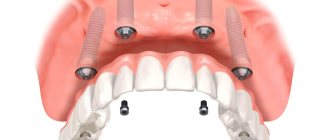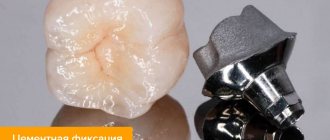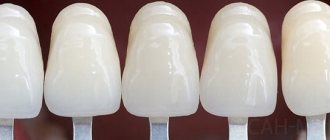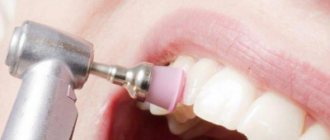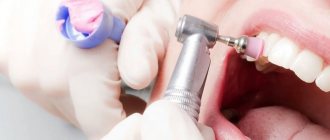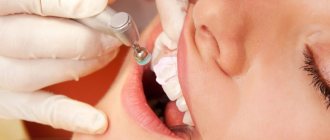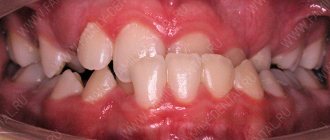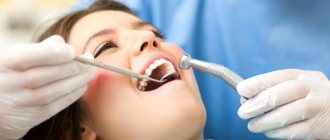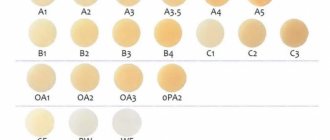November 19, 2010
Tooth enamel is the hardest tissue in the human body. What can harm tooth enamel, and how to keep it healthy?
Tooth enamel is the hardest tissue in the human body. It is thanks to her that a person can eat, chew on dried bread, wash it down with hot tea and at the same time smile dazzlingly. What can harm tooth enamel and how to keep it healthy, says Edith Kuzmina, head of the Department of Prevention of Dental Diseases at Moscow State Medical University.
What determines the color of teeth
It is believed that the color of the enamel determines the color of a person’s teeth, but in fact this is not entirely true. Tooth enamel can be milky white and translucent. Initially, in young people, it is quite dense and almost does not show through the underlying dentin, which in turn has a yellow, grayish or yellow-brown tint. The thicker the enamel, the whiter the teeth. The converse is also true.
Over the course of a person's life, the enamel becomes thinner and the color of the dentin appears. Hence the yellow or grayish smiles of older people. Food, drinks and tobacco also contribute to the darkening of teeth. Don’t forget about dental plaque and tartar, which absorb pigments much more strongly than enamel due to their porous structure.
A sudden change in the color of one or more teeth may indicate the presence of a disease. Thus, with fluorosis, teeth may acquire a brownish tint with whitish spots or stripes. Gray color occurs in pulpless teeth or may indicate heavy metal poisoning.
Why is enamel destroyed?
Rules for caring for first teeth
Why should you brush your baby teeth, and how to do it correctly? Answers that will help save your children's teeth.
Almost all of the enamel consists of solid mineral components - calcium and phosphates - and only 5 percent of organic matter and water.
Minerals can penetrate the surface layers of enamel from saliva, a process called remineralization
.
But under the influence of acids secreted by plaque bacteria, calcium is able to be released back from the enamel into saliva - this is demineralization
of the enamel. Normally, the processes of demineralization and remineralization are in balance. But if teeth are brushed too rarely, or a person constantly abuses foods that contain sugar, bacteria actively multiply in the oral cavity. And they produce too much acid, which destroys the enamel.
How to keep your teeth white
To keep your teeth white, you need to:
- Perform good oral hygiene, including brushing, flossing, and using mouth rinse
- Using a waterpik at least twice a week to get rid of plaque
- Once or twice a year, have your mouth professionally cleaned by a dental hygienist to remove tartar.
- Limit or eliminate smoking, strong tea and coffee
It is also important to make regular visits to the dentist for diagnostic procedures. This will allow timely identification of problems and identification of deterioration of the enamel.
How does smoking affect enamel and teeth?
Tars that enter the oral cavity with tobacco smoke form pigmented plaque, the color of which varies from brown to black. This plaque is firmly fixed on the surface of the teeth and can only be removed with professional cleaning. In addition, smokers develop tartar more intensively, including under the gums. And when you regularly smoke a large number of cigarettes, the components of tobacco smoke accumulate in the enamel, causing darkening of the teeth. By the way, smoking is considered as one of the indicators of tooth loss
. Only 20 percent of non-smokers over 65 years of age suffer from complete absence of teeth, while the figure for smokers is 41.3 percent.
Teeth whitening and restoration techniques
If even careful care and regular professional hygiene do not allow you to completely get rid of yellowness, teeth whitening comes to the rescue. In our articles, we have already examined in detail the advantages and disadvantages of office and home whitening.
When darkening of the teeth is caused by severe thinning of the enamel, dental disease, or a general deterioration in the patient’s health, the first step is to correctly diagnose the problem and carry out appropriate treatment. Afterwards, it is possible to restore your smile with the help of veneers, lumineers and crowns.
We recommend that you try your best to keep your teeth healthy.
How do coffee, soda and candy affect enamel?
Frequent consumption of coffee gives the enamel a yellow tint. “However, this effect is also observed to varying degrees when consuming other foods and drinks that have coloring properties,” notes Kuzmina, “strong tea, chocolate, blueberries, red wine.” Over time, the enamel's sensitivity to food coloring increases; at the same time, the enamel becomes thinner
and loses its transparency, which worsens tooth discoloration. Some experts believe that caffeine has an antibacterial effect and kills streptococci, which are most often responsible for the development of tooth decay. True, the positive effect of coffee is noticeable if you drink no more than two cups a day and brush your teeth regularly. But carbonated and energy drinks, as well as sweets, cause undoubted harm to teeth. These foods contain large amounts of sugar, which plaque bacteria use as a food source. The acids released during the life process cause demineralization of the enamel. In addition, carbonated drinks themselves contain acid, which has a direct aggressive effect on the enamel, dissolving it.
Sample menu for the week
Smile-safe food plan for the first weeks after whitening [3]:
| Days | Breakfast | Snack | Dinner | Dinner |
| 1st and 4th | Oatmeal with milk, cottage cheese, raisins, fermented baked milk. | Yogurt, banana. | Two boiled eggs, green tea with milk, cottage cheese with sour cream. | Cookies, yogurt. |
| 2nd and 5th | Rice porridge with honey, yogurt. | Sandwiches with butter and cheese, yogurt. | Mushroom cheese soup, steamed white meat with vegetables. | Banana, yogurt. |
| 3rd and 6th | Vermicelli porridge with milk, cottage cheese. | A handful of nuts, two boiled eggs. | Noodle soup, boiled potatoes with chicken. | Ryazhenka. |
| 7th | Semolina porridge with milk and butter. | White grapes, peach, peeled apples. | Boiled or baked fish with a side dish of steamed cauliflower. | Salad of peeled cucumbers or light, non-acidic fruits. |
List of sources:
- Burak J. Why teeth darken and how to restore their whiteness, portal “Healthy People” (24health.by), 2022 // URL: https://health.tut.by/news/disease/692875.html (access date: 02.11.2020).
- 10 facts about teeth whitening. Doctor's opinion. ONDOC, 2022 // URL: https://ondoc.me/blog/posts/9 (access date: 12/01/2020).
- Bolotina T.A. White diet after teeth whitening. Blog of practicing dentists DentConsult, 2022 // URL: https://dentconsult.ru/otbelivanie-i-chistka/belaya-dieta-posle-otbelivaniya-zubov.html (date of access: 02.11.2020).
- Vovilyuk A.L. Diet after teeth whitening. Dental portal “Anatomy of teeth”, 2005 // URL: https://yandex.ru/turbo/anzub.ru/s/esteticheskaya-stomatologiya/dieta-posle-otbelivaniya-zubov/ (date of access: 02.11.2020) .
Memo to smokers
A heavy smoker and a Hollywood smile are poorly compatible concepts, so the requirements for this category of patients are especially stringent: in the first two days after the teeth whitening procedure, you must completely give up nicotine, in the next two weeks, smoke a minimum amount of cigarettes (or better yet, switch to an electronic cigarette) .
If these requirements are not met, even after laser whitening, tooth enamel will very soon acquire a yellow tint, nullifying your efforts and costs.
Contraindications to teeth whitening
When a consumer chooses a teeth whitening method, “Which method is best?” is asked to specialists not only to determine the effectiveness of a particular technique. This question also presupposes the possibility of performing the procedure as a whole, since many bleaching methods have the following general absolute relative contraindications, in which bleaching is not performed:
- Serious pathologies of the cardiovascular and respiratory systems in the acute phase.
- Allergic reactions to components used in whitening compositions.
- Periods of pregnancy and breastfeeding.
- Serious enamel damage and deep cracks.
- Any diseases of the oral cavity (whitening becomes possible after treatment and elimination of such pathologies).
- Age up to 16 years.
- Uncontrolled high blood pressure.
- Enlarged pulp chambers of teeth. In such cases, increased sensitivity to mechanical and chemical influences during the procedure may occur.
- The development of tumors and neoplasms of any origin in the oral cavity.
- Exposure of the necks of the teeth. In such cases, home whitening and procedures using large amounts of whitening gels are not recommended.
- Limited mouth opening and inability to keep it open for a long time due to various diseases of the temporomandibular joint.
- Hydrogen peroxide intolerance.
- The presence of defective fillings and crowns, as well as the presence of a large number of fillings, regardless of their condition (in such cases, the filling materials will be noticeable after bleaching due to the fact that bleaching substances do not act on them and do not change their color).
conclusions
Young wines stain teeth enamel more strongly than aged wines. Of the eight samples, according to the results shown by the spectrophotomaterial, the Sangiovese variety turned out to be the strongest.
Varieties according to the strength of influence on the color of the enamel:
- Sangiovese
- Saperavi
- tempranillo
- malbec
- cabernet sauvignon
- Syrah
- merlot
- pinot noir
It is important that after whitening, teeth became more permeable to red wine. That is, if you have whitened your teeth, it is advisable to refrain from drinking red wines for one or two weeks. To maintain the brightness of teeth, dentists recommend using special hygiene accessories - enamel cleaning wipes and specialized toothpastes with a whitening effect.
© Kelsey Knight/Unsplash
Typically, tooth enamel is close to milky white in color.
It is also characterized by translucency. And the color of teeth, which we perceive as the color of enamel, is still determined by the color of dentin, because it is this that shines through the translucent enamel.
In young children, tooth enamel is denser and has a more pronounced relief than in adults. It is for this reason that their teeth look whiter and lighter, since the enamel is less visible. Over time, the enamel becomes thinner and smoother due to its contact with food and drinks, so the enamel becomes even more transparent. And then the natural color of dentin appears through it, which can be yellow, brownish, gray.
One should also take into account the fact that the color itself is uneven in its structure. The closer the dentin is to the edge, the lighter it is, and closer to the root the shade darkens several tones. At the same time, different teeth also have different colors, for example, canines, as a rule, are somewhat darker than the incisors. Even if your teeth become increasingly darker with age, you should not worry: all problems can now be easily solved by aesthetic dentistry . For example, ZOOM laser teeth whitening does an excellent job of returning teeth to their white color, and for those who want to hide some defects in parallel with teeth lightening, there are veneers and lumineers .
You can often hear that dark-skinned people have whiter teeth than light-skinned people. However, this is not quite true. The fact is that the bright whiteness of teeth is partly due to the contrast to dark skin. This is why even if you are slightly tanned, your teeth will appear whiter.
Scientists have repeatedly conducted studies regarding the natural, natural color of teeth in different peoples. The results were not surprising - the shade of enamel and dentin is usually determined genetically and is almost not modified in any way under the influence of external factors. The environment in which a person lives affects the color of teeth to a lesser extent than his heredity.
- Promotion
Dental treatment under anesthesia
Promotion for sedation in Moscow!
If you experience: — Severe stress during dental treatment — Fear of the sound of dental instruments — Time-limited visits to the dentist
old price
12 000 ₽
price
5 900 ₽
Free consultation RUB 5,900 for 30 minutes
Limited offer. Sign up for a free consultation. There are contraindications, consultation with a specialist is required.
- Promotion
Teeth whitening ZOOM
Promotion for teeth whitening in Moscow!
As a gift: - Prof. Oral hygiene – Whitening care set with individual trays
old price
40 000 ₽
price
19 900 ₽
Free consultation Sign up for a free consultation. There are contraindications, consultation with a specialist is required.
When doing prosthetics and dental implantation, the doctor is faced with the task of correctly selecting the shade of the tooth. Of course, the new tooth should not stand out too much in the row, attracting the attention of others. To determine the shade, the so-called Vita scale is used - it is used to create orthopedic structures and to select veneers and lumineers.
The scale itself is a small rail on which samples are attached. These samples are usually made of plastic or metal-ceramic, the latter being considered the best for shade selection as they have the same shine as natural teeth and therefore reflect the color appropriately. The gradation of samples is carried out on a scale from A to D, where the letter A denotes reddish-brown shades, and D – reddish-gray. Next to each letter there is a number from one to four; it indicates the brightness level; the lower the number, the brighter the shade.
Wines and teeth
Young wines with a close harvest interval of 2016–2018 were taken for the study. All wines were varietal. Four are native to Europe and four are from South America. For the purity of the experiment, the teeth of one person were needed so that they did not have fillings and were not subject to bleaching. Such teeth were found, and their removed form was provided for research. After removal, they were stored in saline. Next, for the experiment, the teeth were sawed along the longitudinal axis and eight similar parts were obtained for eight wines. The teeth belonged to a 27-year-old patient and were free of caries.
What will you have to give up?
Sacrifices, however, will be required, because the coloring products that you need to avoid completely for a period of several days to several weeks include your absolute favorites:
- coffee, tea, cocoa
- juices, fruit drinks, carbonated drinks with dyes
- berries, fruits, “colored” vegetables
- sauces, ketchups, hot seasonings (mustard, adjika)
- chocolate and red wine
If you accidentally eat anything on this list, brush your teeth as soon as possible or use a mouthwash designed to remove pigmentation from tooth enamel!
Already two days after the whitening procedure, you can begin introducing prohibited foods into your diet. First - tea/coffee (with milk, no more than one glass per day, it is better to drink through a straw - to minimize the coloring effect on the enamel), the rest of the list - only after 2-3 weeks and gradually. It is also advisable to temporarily give up acidic foods - this will ensure a gentle regime that takes into account the always increased sensitivity of the enamel after bleaching.
Meet the “white diet”
Recommendations for maintaining the results of teeth whitening are based on following a special diet during the first two weeks. It is called colorless, or white, and this is a very correct name, because after the bleaching procedure you should not eat foods containing natural dyes.
The choice of products without dyes is quite wide, so the “white diet” will not require complete self-denial from you. Among the permitted products:
- potatoes and rice;
- white sea fish and chicken;
- White mushrooms;
- white (wheat) bread;
- walnuts and tofu cheese;
- all “milk” (milk, kefir, cottage cheese, etc.);
- pears and green apples.
The essence
Red wine contains tannic acid, which interacts with the protein in saliva, which leads to discoloration of teeth. The color of wine is formed by anthocyanins and tannins, which are contained in the skin of grapes. Each variety has a different quantity, and it is also influenced by production methods, for example, aging in an oak barrel. All these chemical elements lead to tooth pigmentation and the appearance of plaque.
It is important that after whitening, teeth became more permeable to red wine. That is, if you have whitened your teeth, it is advisable to abstain from drinking red wines for one or two weeks
Oral care
In addition to nutrition, you also need to pay attention to proper oral care so that teeth restoration after whitening is as fast and comfortable as possible. First of all, you should spend extra time brushing your teeth - you need to brush them about 2-3 minutes longer than usual, with a medium-hard or soft brush (depending on the condition of the gums). You should also regularly use dental floss to clean the interdental spaces, an irrigator and rinses containing fluoride (to strengthen the enamel).
In the first days after the whitening procedure, you should refrain from smoking at all; in the future, it is recommended to reduce to a minimum the number of cigarettes smoked per day. Women who actively use lipsticks and lip gloss will have to stop using such cosmetics in the first three days after whitening.
The right diet
Many drinks and foods can stain enamel. The most dangerous for snow-white color include:
- Coffee – both instant and brewed;
- Tea, especially black and pu-erh. Green stains the enamel to a lesser extent;
- Red wine;
- Carbonated drinks, colored in various colors;
- Some candies and sweets.
Also, darkening of the enamel is often caused by an incorrect diet, which contains a lot of food with a soft texture and a high content of carbohydrates - sweets, baked goods, desserts, and so on. All of them contribute to the formation of bacterial plaque on the enamel surface.
It is recommended to include more foods with a tough texture in your diet. For example, thoroughly chewing fresh apples after eating cleanses the surface of the teeth from plaque and bacteria. Carrots, pears, celery, broccoli - all this will help keep the enamel white.
